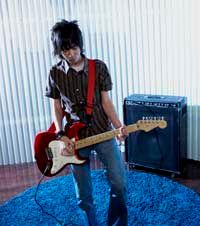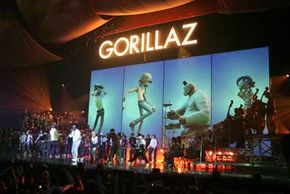Virtual bands are like potlucks. Someone brings a salad, another person a casserole and so on. The host can theme it and request certain things, but when the time comes to eat, that meal depends on the separate contributions of the individuals involved.
Likewise, the first step of forming a virtual band starts with you. Whatever your musical talent -- saxophone, oboe or good ole fashioned guitar -- computer software has made it a cinch to record yourself showing off your skills.
Macintosh computers come standard with the recording program called GarageBand. Pro Tools is a popular program often used by professional musicians. But for that type of quality, you'll have to pay. Other software you can purchase includes Tracktion, Sonar and Nuendo. For freeloaders, Audacity is an open source software that you can download to record. Programs like these save your music into file formats such as MP3, wav and aiff. Once you save your tracks, you're ready to share.
Three popular Web sites have combined social networking with music production: Kompoz, Indaba and eJamming. On Kompoz, people can upload their tracks or songs, allowing other people to add tracks or sample them. You can also add to other people's stuff as well. That means your melody could end up in any number of combinations. Many times, users will work on a variety of projects at one time instead of devoting themselves to a specific band. From there, other members can comment on the tune and rate it. Project creators determine the type of license agreement up front to cover the finished product.
Indaba has the same Facebook-like social networking frame but has its own mixing program that registered users can access. With this program, you can produce music on your own, request help from other members, or close off the session to a select few.
It also lays out guidelines regarding who actually owns the song (which isn't as clear with other sites). Before users begin collaborating, the site allows them to lay down their own guidelines regarding who owns the rights to the song, whether anyone will receive payment for their services and other legal issues [source: Sarno]. Indaba then archives the communications in case of a dispute down the road if, let's say, the single strikes a positive chord with the public.
If you want to practice in real time, eJamming is where it's at. EJamming goes beyond uploading and mixing tracks online. Here, a virtual band can practice playing together and collaborate without physically being in the same room, or country, for that matter. The founders of the Web site patented the technology to link a bongo player in Taiwan with a didgeridoo master in Chicago by minimizing the lag time caused by communicating over a network. (Side note for Rock Band video game fans: this lag issue is what prevented the first version from offering the World Tour mode for online competition.)
According to the eJamming Inc. patent, the software first determines the network delay between the people who wish to jam. Then, when the musicians start playing, the network transmits the sound in accordance to the delay, keeping everyone in sync. For instance, if there is a two second delay between you and another person in Australia, it would normally result in off-kilter melodies. However, if the network reads that delay and matches up the timing when both of you receive the data, you'll hear a harmonious product. Aside from real-time jam sessions, eJamming also allows for recording sessions, using the same technology. According to the site, people participating in a collaborative track will share a copyright for the final product.
So we now know that people can meet, exchange tracks, mix and record online. But what about that integral component to band membership -- performance? Why pour your time and energy into a musical collaboration if you can never receive the glorious adoration of fans?
On the next page, we'll address how some bands use the Web for performing, as well as another take on the concept of a virtual band.


